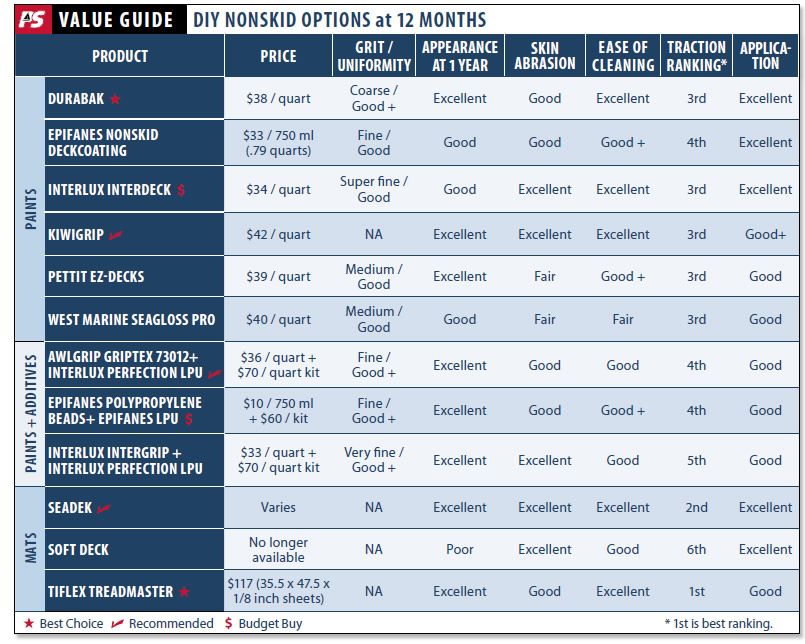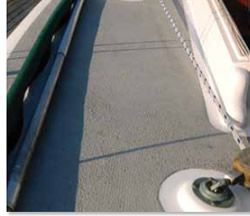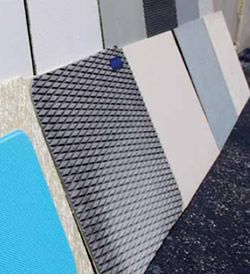
Its been 12 months since testers mounted the nonskid test panels on the roof, subjecting them to south Floridas semi-tropical weather-harsh sun, high humidity, summer rainstorms-around the clock, without any cleaning or other maintenance. The service life of the 12 nonskid paints and mats can range from three years to a decade or more, so we expected to see little change in their integrity at the one-year mark of this long-term exposure test.
Aside from some leaves, grime, and a little bird poop, 75 percent of the test field remained unchanged. Three test panels, however, offered notable results after a year of exposure, including one total failure.
What We Tested
In the January 2012 issue, we launched a test of 11 nonskid products that the average do-it-yourselfer can apply to resurrect weathered decks. The test field included one paint with no filler media, five one-part paints ready-mixed with nonskid compounds, three nonskid additives that can be mixed with any deck paint, one self-adhesive mat, and one mat adhered with epoxy. We added a second self-adhesive mat to the fray with our test update in the July 2012 issue. All can be applied to fiberglass, wood, or metal, and are readily available from online stores and marine chandleries. The paints and additives covered a range of grit sizes-from fine to coarse-but most of the test products are available in multiple grits.
Manufacturers represented in the test included the big names in marine maintenance products-AkzoNobel (Interlux and Awlgrip), Pettit, West Marine, and Epifanes-as well as companies specializing in nonskid, Pachena (KiwiGrip) and Durabak, and three that make nonskid mats for the recreational market, SeaDek, Tiflex, and Soft Deck.
The picks for exceptional grip after our initial round of testing in 2012 were Durabak pre-mixed paint and Tiflexs Treadmaster nonskid mat; both also earned a spot on the 2012 Editors Choice roster (PS, September 2012). KiwiGrip pre-mixed paint and Awlgrip Griptex additive earned testers Recommendation while Interluxs Intergrip additive and Interdeck pre-mixed paint got the Budget Buy picks.
How We Tested
If a boat owner spends the necessary time, effort, and money on a nonskid makeover, it goes without saying that he will expect it to perform well and to last for a while. But a good DIY nonskid also should be affordable, easy to clean, and not too abusive of the crews knees, elbows, and backside. Those are the criteria we looked for when rating the nonskid test products.
Test Launch: Our first report in this long-term test (PS, January 2012) focused on the products ease of application and cleaning, skin abrasion/roughness, and how much traction they offered.
Testers applied the paints and mats to 24- by 16-inch fiberglass panels, per makers instructions. Premixed nonskid paints were stirred well, and additive-only products were mixed with two-part linear polyurethane (LPU) paints before application; we did not broadcast nonskid aggregate on top of the paints. The additives can be mixed with most any marine deck paint, but we chose two-part LPU topside paints for their superior durability. For testing, Awlgrip Griptex and Interlux Intergrip were each mixed with Interluxs two-part Perfection topside paint. We mixed Epifanes Polypropylene beads with Epifanes two-part LPU. Note that some nonskid additives are actual grit while others are micro spheres, or beads, that act as tiny shape formers for the paint. The beads break down over time, creating new edges for traction-and new crannies for dirt to hide in.
KiwiGrip was the only paint that did not have a nonskid aggregate. We applied it in two coats and textured it with the companys supplied loopy-goopy roller.
The self-adhesive Soft Deck and SeaDek mats came pre-cut, but testers had to size the thick Treadmaster mat to fit our test panel and install it using the companys tenacious epoxy adhesive.
To evaluate the nonskids grip after application, we mounted the test panels on a jig that allowed them to be inclined at 5-degree increments. With a tester standing on the panel, we increased the angle of heel until the tester slipped; this was repeated with the tester wearing boat shoes and with bare feet, and with the panels wet and dry. To further evaluate resistance, testers dragged a 10-pound weight attached to a slick shoe tread across the finished surfaces for 1.5 feet, measuring the resistance with a spring scale.
In order to gauge how easy the nonskid products were to clean, testers sullied them with mud-caked boat shoes. Panels that came clean with a quick hosing off were rated Excellent; those with scuffs and dirt that easily cleaned off with a soft-bristle brush were rated Good; and those with dirt remaining were rated Fair. All of the panels withstood scrubbing with a stiff brush.
Because the suns UV rays are a marine coatings worst enemy, testers mounted the 12 nonskid panels on a white rooftop in Sarasota, Fla., where they would get full sun everyday.
We also applied Durabak to the coachroof of one testers 1978 Union 36 in the fall of 2011, after removing his previous nonskid, seven-year-old crushed walnut shells and paint. After two years of regular use, the Durabak coating is doing well, with no signs of excessive wear or adhesion issues. [Update: Since the test started readers have submitted a few reports of Durabak adhesion failure, as we reported in 2016.]
One-year Checkup: The test panels were taken down from the rooftop for an annual checkup in September 2013. After testers noted the appearance and integrity of the coatings and mats, we repeated the ease of cleaning and simulated heeling-angle tests we had carried out a year earlier. Not surprisingly, none of the panels lost any traction performance in 12 months, so their rankings remained the same. Only two test panels showed any adhesion issues (see below), but those were traced back to application challenges.
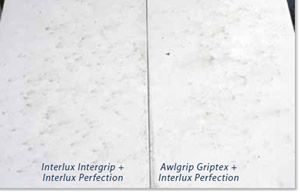
What We Found
Because this long-term exposure test does not have an accelerated wear component and simply subjects the test panels to weathering, we did not expect any earth-shattering findings with this one-year update. Most nonskid paints have UV protection built in and are formulated to last for many years with proper maintenance. Aside from the one failure, the findings at this stage are still considered preliminary. That being said, we were able to make some early recommendations based on traction, ease of application and cleaning, and color retention. For more specific details on each product and their applications, be sure to check out the January 2012 report.
Noteworthy: Only three of the 12 nonskid test panels looked any worse for the wear after a year of 24-7 weather exposure, and testers attributed their suffering to UV radiation in one case and neglect in the other two instances.
The panel that fared the worst by far was the Soft Deck mat. Made of EVA foam, Soft Deck appeared dried out and had a spiderweb of small cracks resembling alligator skin. One section of the formerly dark-gray mat was bleached out by the sun, and cleaning the panel just made matters worse. The dry, sunburned foam crumbled when scrubbed with a medium-bristle brush and boat soap, revealing that the bleached area was larger and lighter than initially observed.
We contacted the maker about the mats lackluster performance, and Soft Decks Ross Champion assured us that if a customer had an experience similar to ours with Soft Deck mats, within 12 months of purchasing, the company would replace the material with an updated version of the product for free.
Soft Deck has discontinued the mat material we tested and replaced it with a less-soft, more robust material, Champion explained. We developed some military specific products. These products are incredibly robust … however, this is not quite as barefoot friendly as the original.
We’ve decided to pull the Soft Deck panel from the test since it was a failure after just 12 months and because it is no longer in production. We plan to test the companys new nonskid mat material for an upcoming article.
The other two test panels with notable appearance changes were the nonskid additives that we mixed with white, two-part Interlux Perfection topside paint: Awlgrip Griptex and Interlux Intergrip. Both panels sprouted an unsightly garden of green mold. However, this was understandable, in our opinion, given that we didn’t clean or maintain the panels at all and that summer 2013 was Sarasota’s rainiest ever on record, making it also a very humid summer, even for Florida.
The mold issue isn’t exclusive to these nonskid products. Be sure to check out Get Longer Life Out of Your Nonskid, a roundup of tips for maintaining nonskid, including ways to prevent mold and mildew growth.
The green blotches on the Griptex and Intergrip panels resisted cleaning with a sponge, but a medium-bristle brush and a little elbow grease got the panels totally clean. Once the mold was removed, these panels looked the best of any of our finer-grit test panels. They appeared to have the hardest finish and were the only paints with any hint of gloss-part of the benefit of mixing the additive with a two-part paint. Testers also noted that the Griptex blend had more additive per square inch than the Intergrip, and that its grit was slightly more coarse.
Paints: The third additive test panel, Epifanes Polypropylene beads mixed with Epifanes two-part topside paint, remained unchanged. It was easy to clean, retained its color, and had no traction or adhesion issues.
The KiwiGrip and Durabak test panels were equally consistent in their performance, with no change in adhesion, grip, or color. Both the stippled KiwiGrip and coarse-grit Durabak were too rough for sponge-cleaning, but they easily came clean and stain-free with a medium-bristle brush and a little elbow grease. In the test field, the Durabak is also meeting expectations and maintaining its top-notch performance.
The super-fine-grit Epifanes Nonskid Deckcoating and Interlux Interdeck single-part, pre-mixed paints were among the easiest test panels to get clean. A few quick wipes with a soft sponge and soap were all they needed. The light-beige Epifanes Deckcoating panel did have one small stain after cleaning where a leaf had stuck to it and apparently traded its tannin for a resting spot.
The light-gray Interdeck did not appear to weather quite as well as some more coarse-grit paints, and testers noted that its lighter color showed dirt more readily than darker paints, but its adhesion and initial traction were uncompromised.
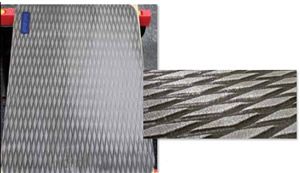
As we reported in this tests launch article, it took both the West Marine SeaGloss Pro and the Pettit EZ-Decks much longer than the other paints to cure in our humid weather (a week-plus versus 24 hours); this can also happen when they are applied in too-thick coats. If the oil-modified polyurethane resin doesn’t completely cure out, the paint will not achieve full hardness and abrasion resistance, making it more vulnerable to shoe marking and other damage for an extended period of time. According to Pettit, the paints need to dry for three to seven days before they are subjected to foot traffic.
Even after eight days of cure time, our test panels had paint peel off the grit when testers stepped on it. (We allowed several more days of cure time before testing.) These small spots seemed to be worsened when we cleaned the panels at the one-year checkup. Also, the worn spots were a little darker in color than the rest of the panels, making the cream-colored SeaGloss Pro and light-gray EZ-Decks panels look dirty even after cleaning.
Mats: Testers were admittedly skeptical of the self-adhesive mats ability to stay stuck for the long-haul, but they were still clinging tightly to the panels at the one-year mark.
The soft SeaDek mat was the easiest to clean; no brush required. But the nonabsorbent, closed-cell EVA foam did have several puncture marks. This did not impact its Excellent grip, however.
Testers were pleasantly surprised to find that the Treadmaster test panel not only performed as it did on Day 1, but it also looked the exact same (except for a few spots of bird poop), even before testers rinsed away the years worth of weather. It showed the least amount of dirt of any test panel and was very easy to clean with a brush.
The one slight drawback to the Treadmaster versus the peel-and-stick mats we tested was its application, which involves mixing and applying some tenacious epoxy adhesive. However, unlike the contact adhesives, epoxy doesn’t set immediately, so its possible to adjust the nonskid mat even after its laid down. This is especially helpful when fitting large panels or doing an installation solo.
After our test began, Tiflex released a new peel-and-stick version of the original Treadmaster. The only difference is its high-performance, pressure-sensitive backing, so we would expect it to have the same unparalleled traction of the original. We will be testing the self-adhesive Treadmaster for a future article.

Conclusion
So which one is the best nonskid product for a do-it-yourself application? Well, the jury is still out as far as which one is the most durable and offers the best long-term grip, but with the exception of the retiring Soft Deck mat, the test panels are all holding up well, and our recommendations changed little since our launch report. To narrow the choices, first determine which products match your aesthetic taste, traction needs, application appetite, and budget, and look for one that strikes the right balance between sure-footedness and skin-friendliness.
Treadmaster held on to its Best Choice picks for their ultimate grip and consistent performance. Durabak’s initial rating recorded in the table below has since slipped based on our update. The SeaDek mat and the nonskid additives followed closely behind in traction tests. While we doubt SeaDek is tough enough to install in all areas where nonskid is desired, its grip, soft footing, and easy installation make it a good choice for spots like the helm station and swim platforms; it earned our Recommendation.
The bonus of choosing one of the mix-in nonskid additives or a product like KiwiGrip is that you can customize the grit to your needs and its location. For example, you can lay on more where there is more foot traffic and lighten it up in favorite crew lounging spots. You can even double-up on the aggregate, sifting an additive atop a premixed paint. The additives also allow you to apply an LPU on deck, and as our tests have shown, these are usually more durable and abrasion-resistant than one-part paints.
We Recommend Awlgrip Griptex for those wanting a more coarse grit, and the media-less KiwiGrip for no grit. Epifanes beads and the skin-friendly Interdeck earned the Budget Buy picks.
Stay tuned for the next chapter in this nonskid test.
